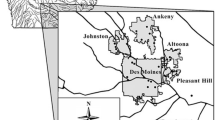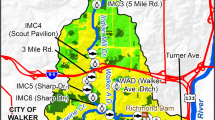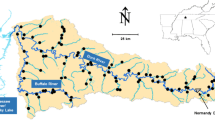Abstract
Headwater streams are typically closely connected with the surrounding watershed landscape, making them sensitive to local watershed conditions. Headwater streams of the Kenai Lowlands in Alaska provide important rearing habitat for juvenile salmon and other biota, and understanding the connections between surrounding landscapes and stream conditions will improve management capabilities. We conducted field evaluations of 30 headwater stream sites on the Kenai Lowlands of Alaska, stratified across watersheds and wetland types, and combined these results with GIS analysis of 12 landscape metrics. Flow-weighted slope (FWS), which is an indicator of the combined influence of percentage cover and topographic position of wetlands, was the best predictor of stream chemistry. Our results revealed distinct differences in water chemistry among headwaters that are largely driven by topography and the amount of wetland in the upstream drainage area. Streams with a high FWS (higher gradient, low wetness) had higher dissolved oxygen and dissolved inorganic nitrogen (mostly nitrate-N), and lower temperatures. Lower FWS streams (low gradient, high wetness) had higher dissolved organic carbon, temperatures, and ammonium and lower dissolved oxygen, all of which were consistent with strong connections between wetlands in watershed and headwater streams. The flow-weighted slope metric is a landscape feature that can be easily derived from GIS, and can be used as a spatially explicit approach for predicting landscape connections to headwater streams on the Kenai Lowlands.



Similar content being viewed by others
References
Alexander RB, Boyer EW, Smith RA, Schwarz GE, Moore RB (2007) The role of headwater streams in downstream water quality. Journal of the American Water Resources Association 43:41–59
Anderson DM, Burnham KP, Thompson WL (2000) Null hypothesis testing: problems, prevalence, and an alternative. Journal of Wildlife Management 64:912–923
Anderson L, Nyberg L (2007) Spatial variation of wetlands and flux of dissolved organic carbon in boreal headwater streams. Hydrological Processes 22:1965–1975
Anderson L, Nyberg L (2008) Relations between topography and stream water chemistry. Hydrology and Earth Systems Sciences Discussions 5:1191–1226
APHA (American Public Health Association) (2005) Standard methods for the examination of water and wastewater. 21st edition. American Public Health Association, and Water Environment Federation, Washington, DC
Baker ME, Weller DE, Jordan TE (2006) Improved methods for quantifying potential nutrient interception by riparian buffers. Landscape Ecology 21:1327–1345
Bedford BL, Goodwin KS (2003) Fens of the United States: distribution, characteristics and scientific connection versus legal isolation. Wetlands 23:608–629
Bellino JC (2009) Effects of geomorphic setting on shallow groundwater exchange and water temperature of salmon bearing streams of the lower Kenai Peninsula, Alaska. MS thesis. University of South Florida
Beven KJ, Kirkby MJ (1979) A physically based variable contributing area model of basin hydrology. Hydrological Sciences Bulletin 24:43–69
Bryant MD, Zymonas ND, Wright BE (2004) Salmonids on the fringe: abundance, species composition and habitat use in high-gradient headwater streams, southeast, Alaska. Transactions of the American Fisheries Society 133:1529–1538
Compton JE, Church MR, Larned ST, Hogsett WE (2003) Nitrogen export from forested watersheds in the Oregon coast range: the role of N2 fixing red alder. Ecosystems 6:773–785
D’Arcy P, Carignan R (1997) Influence of catchment topography on water chemistry in southeastern Quebec Shield Lakes. Canadian Journal of Fisheries and Aquatic Sciences 54:2215–2227
Dillon PJ, Molot LA (1997) Effects of landscape form on export of dissolved organic carbon, iron and phosphorous from forested stream catchments. Water Resources Bulletin 33:2591–2600
Dodds WK, Smith VH, Lohman K (2002) Nitrogen and phosphorus relationships to benthic algal biomass in temperate streams. Canadian Journal of Fisheries and Aquatic Sciences 59:865–874
Elder JF, Rybicki NB, Carter V, Weintraub V (2000) Sources and yields of dissolved carbon in northern Wisconsin stream catchments with differing amounts of peatland. Wetlands 20:113–125
Gorham E, Underwood JK, Janssens JA, Freedman MW, Waller DH, Ogden JG III (1998) The chemistry of streams in southwestern and central Nova Scotia, with particular reference to catchment vegetation and the influence of dissolved organic carbon primarily from wetlands. Wetlands 18:115–132
Gracz M, Noyes K, North P, Tande G (2008) Wetland mapping and classification of the Kenai Lowland, Alaska. http://www.kenaiwetlands.net. accessed: 1-26-11
Hedin LO, von Fischer JC, Ostrom NE, Kennedy BP, Brown MG, Robertson GP (1998) Thermodynamic constraints on nitrogen transformations and other biogeochemical processes at soil-stream interfaces. Ecology 79:684–703
Hill AR, Carducci M (2004) Denitrification and organic carbon availability in riparian wetland soils and subsurface sediments. Soil Science Society of America Journal 68:320–325
Hurd TM, Gökkaya K, Kiernan BD, Raynal DJ (2005) Nitrogen sources in adirondack wetlands dominated by nitrogen-fixing shrubs. Wetlands 25:192–199
Huusko A, Greenberg L, Stickler M, Linnansaari T, Nykanen M, Vehanen T, Koljonen S, Louhi P, Alfredsen K (2007) Life in the ice lane: the winter ecology of stream salmonids. River Research and Applications 23:469–491
Kachemak Bay Research Reserve and National Oceanic and Atmospheric Administration, Coastal Services Center (2001) Kachemak Bay Ecological Characterization. CD-ROM. NOAA/CSC/20017-CD. Charleston, SC: NOAA Coastal Services Center
King RS, Baker ME, Whigham DF, Weller DE, Jordan TE, Kazyak PF, Hurd MK (2005) Spatial considerations for linking watershed land cover to ecological indicators in streams. Ecological Applications 15:137–153
King RS, Walker CM, Whigham DF, Baird SJ, Back JM (2012) Topography and wetland geomorphology drive macroinvertebrate community structure and juvenile salmonid distributions in southcentral Alaskan headwater streams. Freshwater Science. doi:10.1899/11-109.1
Lazorchak JM, Klemm DJ and Peck DV (1998) Environmental Monitoring and Assessment Program Surface Waters: Field Operations and Methods for Measuring the Ecological Condition of Wadeable Streams. U.S. Environmental Protection Agency Ecosystems Research Branch Ecological Exposure Research Division National Exposure Research Laboratory.
Lowe WH, Likens GE (2005) Moving headwaters to the head of the class. Bioscience 55:196–197
Lucassen ECHET, Smolders AJP, Boedeltje G, van den Munckhof PJJ, Roelofs JGM (2006) Groundwater input affecting plant distribution by controlling ammonium and iron availability. Journal of Vegetation Science 17:425–434
Mauger S (2005) Lower Kenai Peninsula salmon streams: annual water quality assessment. Homer Soil and Water Conservation District and Cook Inlet Keeper p 62
McCune B, Grace JB (2002) Analysis of ecological communities. MjM Software Design, Gleneden Beach, p 300
Meyer JL, Strayer DL, Wallace JB, Eggert SL, Helfman GS, Leonard NE (2007) The contribution of headwater streams to biodiversity in river networks. Journal of the American Water Resources Association 43:86–103
Meyer JL, Wallace JB (2001) Lost linkages and lotic ecology: rediscovering small streams in Ecology: Achievement and Challenges. 41st Symposium of the British Ecological Society, pp 295–317.
Nadeau T, Rains MC (2007) Hydrologic connectivity between headwater streams and downstream waters: how science can inform policy. Journal of the American Water Resources Association 43:118–133
Nakagawa Y, Shibata H, Satoh F, Sasa K (2008) Riparian controls on NO3-, DOC, and Fe concentrations in mountainous streams, northern Japan. Limnology 9:195–206
Ogawa A, Shibata H, Suzuki K, Mitchell MJ, Ikegami Y (2006) Relationship of topography to surface water chemistry with particular focus on nitrogen and organic carbon solutes within a forested watershed in Hokkaido, Japan. Hydrological Processes 20:251–265
Peterson BJ, Wolheim WM, Mulholland PJ, Webster JR, Meyer JL, Tank JL, Marti E, Bowden WB, Valett HM, Hershey AE, McDowell WH, Dodds WK, Hamilton SK, Gregory S, Morrall DD (2001) Control of nitrogen export from watersheds by headwater streams. Science 292:86–90
Pinay G, Black VT, Planty-Tabacchi AM, Gumiero B, Décamps H (2000) Geomorphic control of denitrification in large river floodplain soils. Biogeochemistry 50:163–182
Quinn TP (2005) The behavior and ecology of pacific salmon and trout, 1st edn. University of Washington Press, Seattle, p 378
R Development Core Team (2009) R: a language and environment for statistical computing. R package version 2.10.1 Vienna, Austria.
Reynolds KM (1990) Preliminary classification of forest vegetation of the Kenai Peninsula, Alaska. PNW-RP-424
Richardson JS, Danehy RJ (2007) A synthesis of the ecology of headwater streams and their riparian zones in temperate forests. Forest Science 53:131–147
Shaftel RS, King RS, Back JA (2011) Breakdown rates, nutrient quality, and macroinvertebrate colonization of bluejoint grass litter in headwater streams of the Kenai Peninsula, Alaska. Journal of the North American Benthological Society 30:386–398
Shaftel RS, King RS, Back JA (2012) Alder cover drives nitrogen availability in Kenai Lowland headwater streams, Alaska. Biogeochemistry 107:135–148
Smith RD, Amman A, Bartoldus C and Brinson MM (1995) An approach for assessing wetland functions using hygeomorphic classification, reference wetlands and functional indices. Wetlands Research Program technical report (WRP-DE-9).
Sorenson R, Zinko U, Seibert J (2006) On the calculation of the topographic wetness index: evaluation of different methods based on field observations. Hydrology and Earth System Sciences 10:101–112
Thomas JD (1997) The role of dissolved organic matter, particularly free amino acids and humic substances, in freshwater ecosystems. Freshwater Biology 38:1–36
Triska FJ, Duff JH, Sheibley RW, Jackman AP, Avanzino RJ (2007) DIN retention-transport through four hydrologically connected zones in a headwater catchment of the Upper Mississippi River. Journal of the American Water Resources Association 43:60–71
Viereck LA, Dyrness CT, Batten AR, Wenzlick KJ (1992) The Alaska vegetation classification. PNW-GTR-286
Waddington JM, Roulet NT (1997) Groundwater flow and dissolved carbon movement in a boreal peatland. Journal of Hydrology 191:122–138
Whigham DF, Walker CM, King, RS, Baird SJ (2011) Vegetation patterns associated with first-order streams in the Kenai Lowlands, Alaska. Wetlands (in press)
Wipfli MS, Richardson JS, Naiman RJ (2007) Ecological linkages between headwater streams and downstream ecosystems: transport of organic matter, invertebrates and wood down headwater stream channels. Journal of the American Water Resources Association 43:72–85
Wood SN (2008) Fast stable direct fitting and smoothness selection for generalized additive models. Journal of the Royal Statistical Society 70:495–518
Zuur AF, Ieno EN, Walker NJ, Saveliev AA, Smith GM (2009) Mixed effects models and extensions in ecology with R. Springer, New York
Zuur AF, Ieno EN, Elphick CS (2010) A protocol for data exploration to avoid common statistical problems. Methods in Ecology and Evolution 1:3–14
Acknowledgements
This project was funded by a grant from the US EPA grant number CD-96011801-0, and through additional support through Baylor University, the Kachemak Bay Research Reserve and the Smithsonian Environmental Research Center. Many people assisted with the rigorous field work necessary to collect the field data for this project including Amy Alderfer, Jennifer Brewer, Shan Burson, Kim Cooney, Patrick Dougherty, Dwayne Evans, Rachel Hovel, Megan Murphy, Caitlin Schott, Simeon Smith, and Scott Thompson. We appreciate and thank Kathy Boomer, Jay O’Neill, three anonymous reviewers, and especially Scott Leibowitz for providing valuable comments and edits on manuscript drafts. We especially thank Jeff Back and Conrad Field for their field efforts, and Phil North for his support and encouragement.
Author information
Authors and Affiliations
Corresponding author
Rights and permissions
About this article
Cite this article
Walker, C.M., King, R.S., Whigham, D.F. et al. Landscape and Wetland Influences on Headwater Stream Chemistry in the Kenai Lowlands, Alaska. Wetlands 32, 301–310 (2012). https://doi.org/10.1007/s13157-011-0260-x
Received:
Accepted:
Published:
Issue Date:
DOI: https://doi.org/10.1007/s13157-011-0260-x




